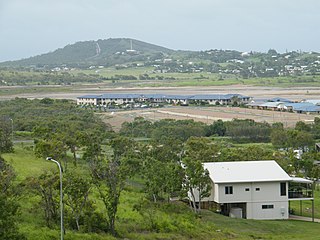
Yeppoon is a coastal town and locality in the Shire of Livingstone, Queensland, Australia. Yeppoon is renowned for its beaches, tropical climate, and the islands out on the bay. Located 41 kilometres (25 mi) from the city of Rockhampton, Yeppoon is the seat of the Shire of Livingstone and the principal town on the Capricorn Coast, a string of seaside communities stretching more than 150 kilometres (93 mi) from north to south. The beaches and shallow coves provide a destination both for tourists and retirees settling down in Central Queensland. Offshore, there are 27 islands including Great Keppel Island which is 20 kilometres (12 mi) from Yeppoon. In the 2021 census, the locality of Yeppoon had a population of 7,037 people; this does not include any neighbouring suburbs.

Westwood is a town in the Rockhampton Region and a locality split between the Rockhampton Region and the Shire of Banana in Queensland, Australia. It was the first town that was gazetted by the Queensland Government. In the 2021 census, the locality of Westwood had a population of 199 people.

The Rockhampton Region is a local government area (LGA) in Central Queensland, Australia, located on the Tropic of Capricorn about 600 kilometres (370 mi) north of Brisbane. Rockhampton is the region's major city; the region also includes the Fitzroy River, Mount Archer National Park and Berserker Range.

Kawana is a suburb of Rockhampton in the Rockhampton Region, Queensland, Australia. In the 2021 census, Kawana had a population of 4,434 people.

Zilzie is a coastal locality in the Livingstone Shire, Queensland, Australia. In the 2021 census, Zilzie had a population of 2,846 people.

Morinish is a rural locality in the Rockhampton Region, Queensland, Australia. In the 2021 census, Morinish had a population of 62 people.

Bajool is a rural town and locality in the Rockhampton Region, Queensland, Australia. In the 2021 census, the locality of Bajool had a population of 447 people.

Canoona is a rural locality in the Livingstone Shire, Queensland, Australia. It was the site of the first North Australian gold rush. In the 2021 census, Canoona had a population of 90 people.

Nerimbera is a rural locality in the Livingstone Shire, Queensland, Australia. In the 2021 census, Nerimbera had a population of 285 people.

Mount Chalmers is a rural town and locality in the Livingstone Shire, Queensland, Australia. In the 2021 census, the locality of Mount Chalmers had a population of 226 people.

Park Avenue is a suburb of Rockhampton in the Rockhampton Region, Queensland, Australia. In the 2021 census, Park Avenue had a population of 5,292 people.

The Caves is a rural town and locality in the Livingstone Shire, Queensland, Australia. In the 2021 census, the locality of The Caves had a population of 680 people.
Lakes Creek is a suburb split between Rockhampton Region and Shire of Livingstone, Queensland, Australia. In the 2021 census, Lakes Creek had a population of 633 people.
Etna Creek is a rural locality in the Livingstone Shire, Queensland, Australia. In the 2021 census, Etna Creek had a population of 1,029 people.
Glenlee is a rural locality in the Livingstone Shire, Queensland, Australia. In the 2021 census, Glenlee had a population of 1,193 people.

Canal Creek is a rural locality in the Livingstone Shire, Queensland, Australia. In the 2021 census, Canal Creek had "no people or a very low population".

Thompson Point is a coastal locality in the Livingstone Shire, Queensland, Australia. It was the site of a short-lived town and port called Broadmount. In the 2021 census, Thompson Point had "no people or a very low population".
Kunwarara is a rural locality in the Livingstone Shire, Queensland, Australia. In the 2021 census, Kunwarara had a population of 69 people.
South Yaamba is a rural locality in the Rockhampton Region, Queensland, Australia. In the 2021 census, South Yaamba had a population of 79 people.
Rockhampton–Yeppoon Road is a non-continuous 39.8 kilometres (24.7 mi) road route in the Rockhampton and Livingstone local government areas of Queensland, Australia. Most of the route is designated as State Route 4 (Regional) and Tourist Drive 10. It is a state-controlled regional road.
















